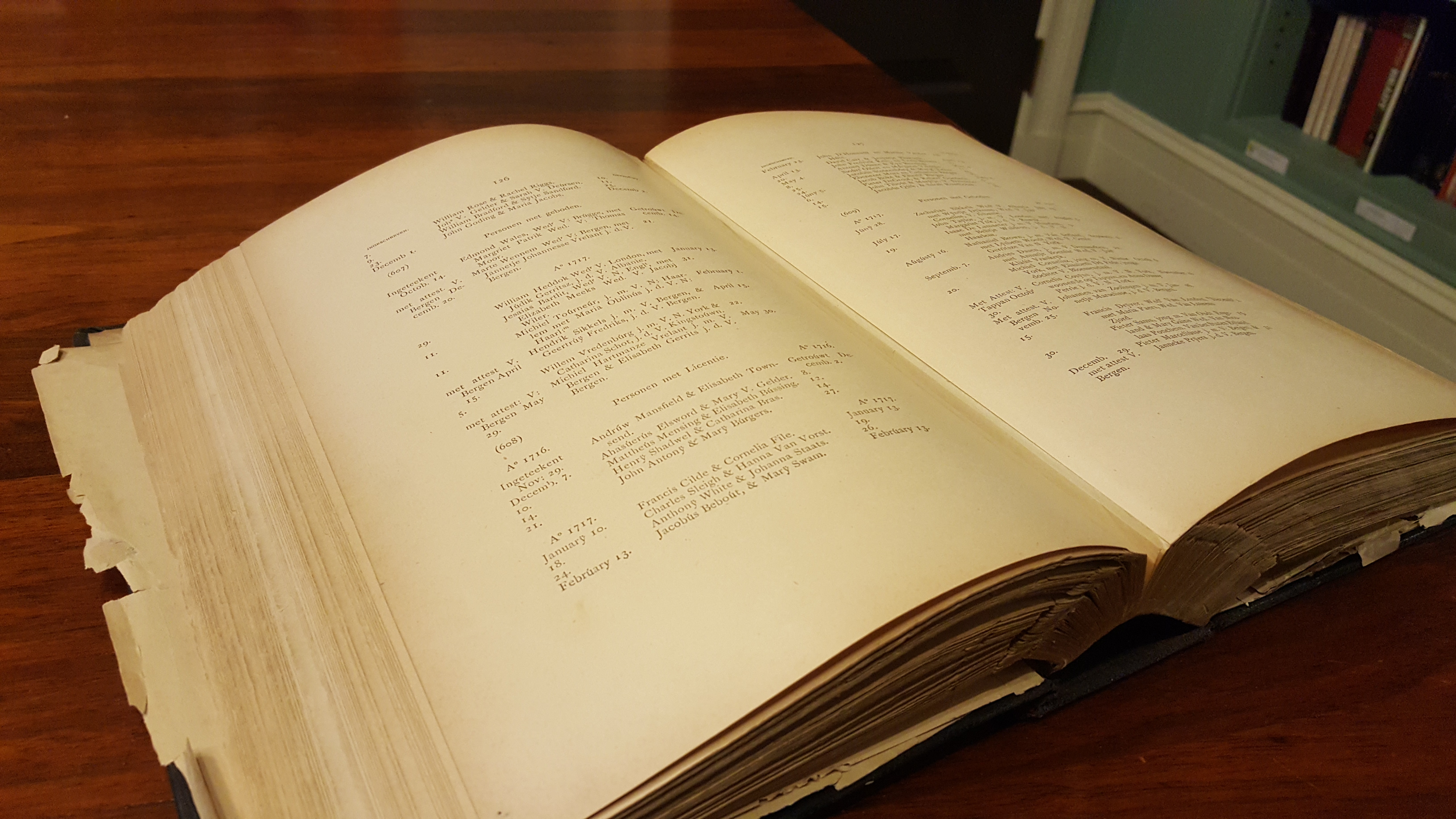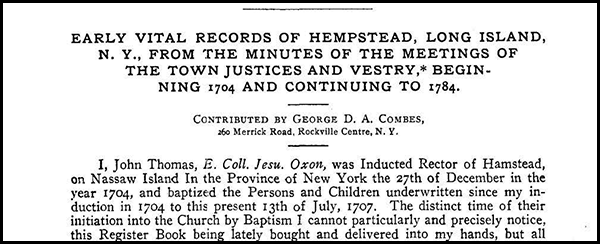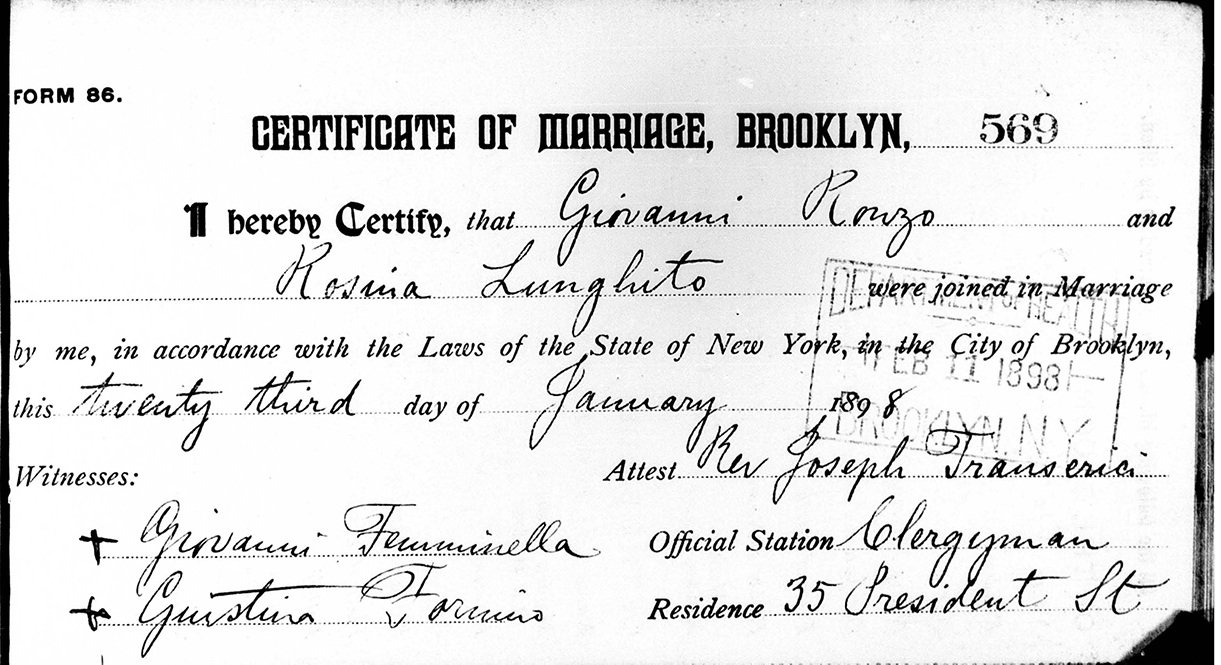Finding a birth, marriage, or death certificate for one of your ancestors is a crucial step in your family history research, but it can be challenging for ancestors who lived in New York State.
You'll have a better chance at success if you're familiar with the history of New York vital records—the more you know about civil vital record keeping in the time period of interest, the more likely you are to look in the correct place right off the bat. Advanced preparation will save you a lot of time and frustration, and may even steer you completely clear of a brick wall.
This article will review the need-to-know history of New York vital records and will help set you on the right path to finding that birth, marriage, or death certificate.
There is a general summary at the end of this article, and the next step is to visit our comprehensive Guide to Finding New York Birth, Marriage, and Death Records, which contains specific instructions for locating vital certificates.
Please Note: As of November 2019 we have been informed that processing times for vital records from the state of New York are extremely lengthy (more than 22 months). Therefore, we encourage you to request records from the local jurisdiction where possible.
Timeline of New York Vital Record Keeping
Read on for a timeline that traces the evolution of New York's vital record keeping throughout history. It is meant more as a general overview than a comprehensive history of the topic.
Pre-1664: Dutch colonial laws
No civil vital records exist for this time period - the colonial Dutch viewed tracking births, marriages, and deaths as a function best served by the church, not the state.1
For this reason, some good substitute vital records for New York can be found in records of the Dutch Reformed Church, the primary church governing the earliest New Netherland and some New York settlers. Our New York State Religious Records collection includes colonial baptism and marriage records from this church and many others.

substitute for those researching colonial Dutch ancestors and others.
Click here to see Dutch Reformed records in the eLibrary.
1665: English and early American record keeping
After the takeover of New Netherland by the English, the overseers of New York established a law that,
“The minister or town clark of every parrish shall well and truly and plainly record all births marriages and burials that shall happen within his respective parrish, in a book to be provided by the churchwardnener for that purpose, and if any master of a family or other person concerned shall omitt the giving notice to the said minister or town clark … such person for his neglect shall be fined five shillings.”2
Unfortunately, anyone with experience researching colonial families in the New York colony will be able to quickly tell you that town clerks almost never followed this law.3
There are a few notable exceptions, particularly on Long Island. The digital archive of The NYG&B Record has a number of abstracts of records from the 1600s and 1700s, including town clerk records from Huntington, Southold, Hempstead, Gravesend and other locations in Queens (some parts now Nassau) and Suffolk counties.

The New York Family History Research Guide and Gazetteer contains specific citations to these articles - researchers can also consult an index to The Record or search the digital archive.
Ministers seem to have done better than town clerks, although it’s hard to definitively assess how many congregations kept track as instructed because many religious records have been lost.
Religious records are still some of the best early substitutes, and many congregations do have records from the 1700s still in existence. Our eLibrary has a large collection of New York religious records that covers this time period and beyond.
Early 1800s: New York City begins recording some vital records
Not much happened during the colonial, revolutionary, or early statehood periods that caused New York (colony, then state) as a whole to keep better track of vital records. Out of necessity, New York City began to form its own system for tracking this information. The first lists of New York City deaths were for Yellow Fever victims in 1795. But those lists only contain those who died of the epidemic, not all deaths. Beginning in 1802, the New York City Board of Health began recording burials. These can be found at the New York City Municipal Archives or accessed via microfilm at the New York Public Library and Family History Library.4 Some digital images may be accessed at Family History Centers.
Note that New York City at this time was only the island of Manhattan and a few other small islands, and this is only the date some burials began to be formally recorded. Coverage will vary depending on the specific location. Areas that are now a part of New York City (but weren't during the majority of the 1800s) may have started record keeping at a different time. For a thorough review of all material located at the Municipal Archives, see the New York City Municipal Archives: An Authorized Guide.
Some, but not all marriages were recorded by New York City as early as 1829, and are available at the Municipal Archives. These records are fairly scattered until closer to the mid- to late- 1800s.5
Civil marriage records from around the state are available for certain locations as well - as an example, The Record holds some civil marriage abstracts from municipalities in Dutchess, Suffolk, Westchester, and Orleans counties. See the New York Family History Research Guide and Gazetteer for specific citations, or search The Record or one of its indexes.
1847: New York State’s first major vital records law
In 1847, the National Medical Convention in Philadelphia issued a call to urge state governments to begin keeping informative and accurate records of births, marriages, and deaths.
New York answered the call with “An Act Providing for the Registry of Births, Marriages, and Deaths” the same year.
The law directed records to be charted at the school district level, and stored with town or city clerks. As the New York Family History Research Guide and Gazetteer notes, “It also required physicians and professional midwives to record births, physicians to record deaths, clergymen to record funerals and marriages, and sextons to record death and burials...For most municipalities in New York State, this 1847 law marks the date of the earliest extant vital records created systematically by the civil administration” (emphasis added)
Unfortunately, many counties in the state objected to this law, and it didn’t take long for compliance to lapse once again - by 1850, the law was largely ignored in many places throughout New York State. Records generated during this period are often found with local governments or have been transcribed by various organizations and individuals.
If you’re seeking records around this time period, it’s a good idea to start by researching the history of vital record keeping in the location of interest. Our county guides contain this information for all counties in NY state.
1860s: New York City vital certificates officially begin
In 1866 the New York City Metropolitan Board of Health was created - this marks the official beginning of civil birth, marriage, and death certificates in New York City and Brooklyn (though Brooklyn began keeping death certificates slightly earlier, and earlier birth, marriage, and death recordings were made in registers).
In general, compliance was better from this point on in New York City history researchers seeking certificates after this time period can be relatively more hopeful. In general, the New York City Municipal Archives will have records from Brooklyn, Queens, and Staten Island beginning around this general time period—still, researchers investigating events that occurred before the 1898 consolidation should explore repositories local to the borough/town as well.
For available indexes to New York City vital records (many of which are freely available online), see the New York City section of our online guide to finding birth, marriage, and death records in New York.

1870s: Other major NY State cities begin their own vital record keeping
By the 1870s, other cities in New York were getting impatient with the essentially non-existent state of vital record keeping and began rolling out their own systems. Albany, Buffalo, and Yonkers all started vital record keeping systems that would remain independent from New York State until 1914:
- Albany began vital record keeping in 1870
- Buffalo began vital record keeping in 1878
- Yonkers began vital record keeping in 1875
To learn more about the local repositories for these three cities, see our Guide to Finding New York Birth, Marriage, and Death Records for contact information.
Other municipalities, including Long Island City, Rochester, Syracuse, and Utica made attempts to keep their own records during this decade, with varying results.6 Researchers interested in these cities should complete a full study of when records began to be created consistently, and where those records are.
One useful resource for tracking this kind of information is the WPA red book - Guide to Public Vital Statistics Records in New York State (including New York City). This work, produced by the WPA during the Great Depression, is current up to 1942 and may help researchers locate early vital records. A digital copy can be found in the NYG&B eLibrary WPA collection. Here's a clip from a Facebook Live Genealogy Q&A where we talked about the Red Books:
1880: The “beginning” of modern vital record keeping
New York State created a Board of Health and a Bureau of Vital Statistics in 1880. Within the next two years, a series of laws were passed that required every town and village in New York State to record births, marriages, and deaths - this law placed local boards of health in villages, towns, and cities as the primary organizations responsible for keeping these statistics.
Over the next couple of decades, more laws were passed that slowly solidified and regularized vital record keeping practices throughout the state. An 1885 law was the first to officially require local authorities to send copies of the original certificates to the State Board of Health in Albany.
Unfortunately, the laws were apparently not harsh enough to induce compliance. According to NYFHRGG, “Most reviews of vital records of New York give 1880 and 1881 as the official beginning of modern record-keeping in New York State. As a practical matter, however, these dates are less important than one might assume. Start-up was uneven, and compliance over the next 30+ years was far from perfect.”7
Despite that disappointing reality, New York State vital record indexes - birth, marriage, and death records each have their own index - all begin in 1880 or 1881. See our Guide to Finding New York Birth, Marriage, and Death Records for details on where to access these indexes. Though record keeping is imperfect until 1914, there are still a significant number of certificates to be found from this time period. As with other time periods, if you cannot find a certificate in the New York State index, it’s a good idea to check with local authorities.
1913: The actual beginning of modern vital record keeping
New York State made continual attempts to incentivize compliance with vital record keeping laws since 1880, and the definitive breakthrough occurred in 1913.
With “An Act to Amend the Public Health Law, in Relation to Vital Statistics”, New York established substantial fines and even imprisonment for officials found in noncompliance. Additionally, the law outlined processes for the state to take over the vital record keeping practice for jurisdictions that could not comply.
The law also precisely spelled out what information should be included in birth, marriage, and death certificates. Experts agree that this date marks the official beginning of the modern system of vital records management in New York State - some mark 1913 as the first year of full compliance, and others believe that true, full compliance didn’t begin until 1914.
It is important to note that after this law, the cities of Albany, Buffalo, and Yonkers no longer kept separate vital records - certificates created in these municipalities after 1914 can be found with the rest of New York State vital records.
Summary
As you now know, the history of New York state vital records is quite complex - but by understanding the landscape for each period in history, you'll have a better idea of what to do when you're researching an ancestor in a particular time and place.
In very general, high-level terms, here is a summary of NY vital record history.
New York City vital records:
- Kept separately from the rest of New York State.
- Record keeping generally began in the mid-1800s, but some records can be found from the early part of the century.
- Records are with the New York City Municipal Archives, and sometimes other more local repositories.
Vital records from all other NY State municipalities:
- Vital records prior to 1847
- Most researchers will need to seek vital record substitutes - vital records simply did not exist for the majority of NY State before this period.
- Vital records between 1847 and 1880
- Civil vital records may be found for this period, but there aren’t many. Most towns did not comply, but some did - investigate at the local level.
- Vital records between 1880 and 1914
- State-wide vital record indexes begin in 1880 - records can be found and ordered from the NYS Department of Health in Albany. Coverage wasn’t perfect during this time period.
- Vital records after 1914
- Certificates after this year are highly likely to exist and can be ordered from the NYS Department of Health.
Our Guide to Finding New York Birth, Marriage, and Death Records provides further detail on each time period and location, including methods of ordering certificates, and where to find online indexes to locate the information you need to order a certificate.
More Genealogy Reading
- Guide to Finding New York Birth, Marriage, and Death Records
- Find a photo of any NYC Building from 1940
-
Using Google Earth for genealogy: Putting your ancestors on the map
-
How to use periodicals for New York Dutch genealogy research
Citations
1. New York Family History Research Guide and Gazetteer (New York: New York Genealogical and Biographical Society, 2018) p. 15 ^ Return to text
2. Colonial Laws of New York, Vol. 1 (Albany: James B. Lyon, 1894) p. 19 Accessed via Google Books, Jan. 17, 2019. ^ Return to text
3. New York Family History Research Guide and Gazetteer, p. 15. ^ Return to text
4. Ibid., 16 ^ Return to text
5. Aaron Goodwin, New York City Municipal Archives: An Authorized Guide for Family Historians. (New York: New York Genealogical and Biographical Society, 2016) p. 13 ^ Return to text
6. New York Family History Research Guide and Gazetteer, p. 18. ^ Return to text
7. Ibid. ^ Return to text